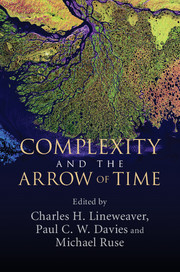Book contents
- Frontmatter
- Contents
- Author biographies
- Part I Introduction
- Part II Cosmological and physical perspectives
- 2 Directionality principles from cancer to cosmology
- 3 A simple treatment of complexity: cosmological entropic boundary conditions on increasing complexity
- 4 Using complexity science to search for unity in the natural sciences
- 5 On the spontaneous generation of complexity in the universe
- 6 Emergent spatiotemporal complexity in field theory
- Part III Biological complexity, evolution, and information
- Part IV Philosophical perspectives
- Index
- References
3 - A simple treatment of complexity: cosmological entropic boundary conditions on increasing complexity
from Part II - Cosmological and physical perspectives
Published online by Cambridge University Press: 05 July 2013
- Frontmatter
- Contents
- Author biographies
- Part I Introduction
- Part II Cosmological and physical perspectives
- 2 Directionality principles from cancer to cosmology
- 3 A simple treatment of complexity: cosmological entropic boundary conditions on increasing complexity
- 4 Using complexity science to search for unity in the natural sciences
- 5 On the spontaneous generation of complexity in the universe
- 6 Emergent spatiotemporal complexity in field theory
- Part III Biological complexity, evolution, and information
- Part IV Philosophical perspectives
- Index
- References
Summary
THE COMPLEXITY OF COMPLEXITY
Proud Biologist: “Life forms are more complex than stars”
Humble Astronomer: “You'd look simple too from a trillion miles away”
One of the central questions of evolutionary biology and cosmology is: is there a general trend towards increasing complexity? In order to answer that question, it would help to have a definition of complexity that can be quantified. Various definitions of complexity have been proposed (Gell-Mann, 1994, 1995; Kauffman, 1995; Adami, 2002; Gell-Mann & Lloyd, 2003; Fullsack, 2011). With useful oversight, Lloyd (2001) groups various conceptions of complexity into three groups based on (1) difficulty of description (measured in bits) (2) difficulty of creation (measured in time, energy or price) and (3) degree of organization (measured in…?…, we're not sure). For more details see: Weaver, 1948; Traub et al., 1983; Chaitin, 1987; Weber et al., 1988; Wicken, 1988; Bennett, 1988; Lloyd & Pagels, 1988; Zurek, 1989; Crutchfield & Young, 1989; McShea, 2000; Adami et al., 2000; Adami, 2002; Hazen et al., 2008; Li & Vitanyi, 2008; McShea & Brandon, 2010.
- Type
- Chapter
- Information
- Complexity and the Arrow of Time , pp. 42 - 67Publisher: Cambridge University PressPrint publication year: 2013
References
- 3
- Cited by



